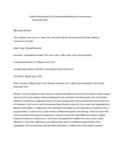Mostrar el registro sencillo del ítem
Strategic noise map of a major road carried out with two environmental prediction software packages
| dc.creator | Arana Burgui, Miguel | es_ES |
| dc.creator | San Martín Murugarren, Ricardo | es_ES |
| dc.creator | San Martín Erviti, María Luisa | es_ES |
| dc.creator | Aramendía Santamaría, Emilio | es_ES |
| dc.date.accessioned | 2017-03-29T09:27:05Z | |
| dc.date.available | 2017-03-29T09:27:05Z | |
| dc.date.issued | 2010 | |
| dc.identifier.issn | 0167-6369 (Print) | |
| dc.identifier.issn | 1573-2959 (Electronic) | |
| dc.identifier.uri | https://hdl.handle.net/2454/23971 | |
| dc.description | The final publication is available at Springer via http://dx.doi.org/10.1007/s10661-009-0853-5 | en |
| dc.description.abstract | The main objective of this study is to analyze the differences found in the results of noise mapping using two of the most popular software techniques for the prediction of environmental noise. The location selected to conduct the comparative study is an area encompassed by the ring road that surrounds the city of Pamplona and on a grid, with a total of 6 × 105 points, approximately. In fact, and as the Environmental Noise Directive points out, it is a major road designated by a Member State (Spain). Configuration of the calculation parameters (discretization of the sources, ground absorption, reflection order, etc.) was as equivalent as possible as far as programs allow. In spite of that, a great number of differences appear in the findings. Although in 95.5% of the points the difference in the noise level calculated from the two programs was less than 3 dB, this general statistic result concealed some great differences. These are due to the various algorithms that programs implement to evaluate noise levels. Most differences pertain to highly screened receivers or remote ones. In the former, the algorithm of visibility is the main cause of such differences. In the latter, differences are mainly brought about by a different implementation of the propagation under homogeneous and favorable atmospheric conditions from both software systems. | en |
| dc.description.sponsorship | The authors would like to deeply thank to the Environmental Department of the Government of Navarre for their grant to carry out this research. | en |
| dc.format.mimetype | application/pdf | en |
| dc.language.iso | eng | en |
| dc.publisher | Springer Netherlands | en |
| dc.relation.ispartof | Environmental Monitoring and Assessment (2010) 163:503–513 | en |
| dc.rights | © Springer Science + Business Media B.V. 2009 | en |
| dc.subject | Noise | en |
| dc.subject | Software | en |
| dc.title | Strategic noise map of a major road carried out with two environmental prediction software packages | en |
| dc.type | Artículo / Artikulua | es |
| dc.type | info:eu-repo/semantics/article | en |
| dc.contributor.department | Física | es_ES |
| dc.contributor.department | Fisika | eu |
| dc.rights.accessRights | Acceso abierto / Sarbide irekia | es |
| dc.rights.accessRights | info:eu-repo/semantics/openAccess | en |
| dc.identifier.doi | 10.1007/s10661-009-0853-5 | |
| dc.relation.publisherversion | https://dx.doi.org/10.1007/s10661-009-0853-5 | |
| dc.type.version | Versión aceptada / Onetsi den bertsioa | es |
| dc.type.version | info:eu-repo/semantics/acceptedVersion | en |


